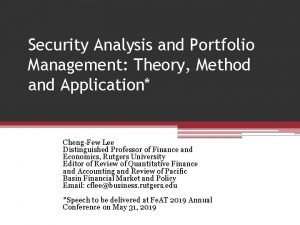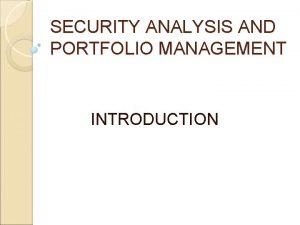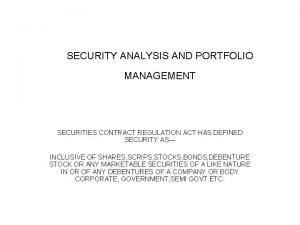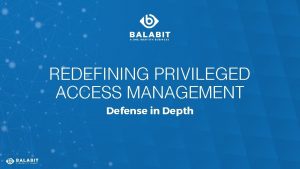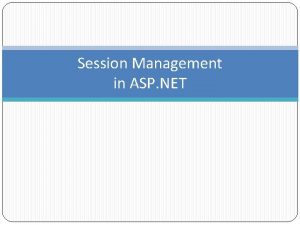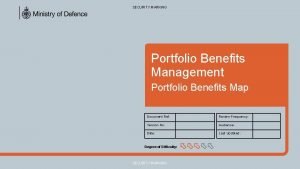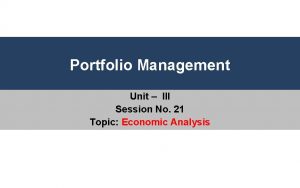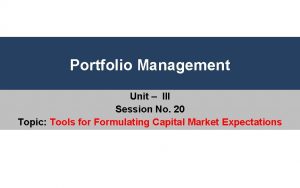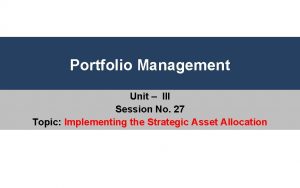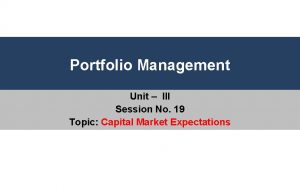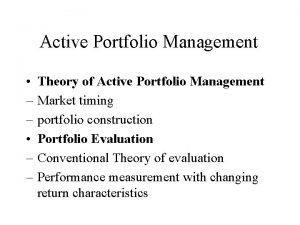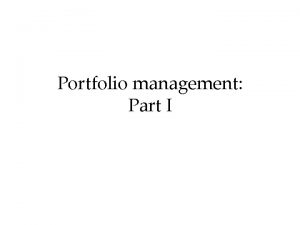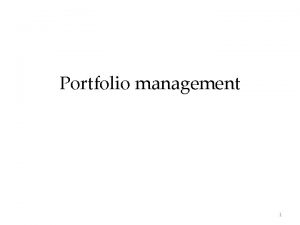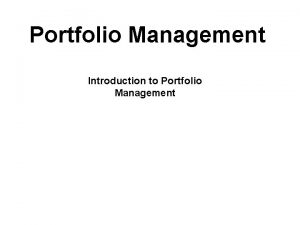Security Analysis Session III Portfolio Management Portfolio v

























- Slides: 25

Security Analysis Session III Portfolio Management

Portfolio v Portfolio is a combination of securities such as stocks, bonds and money market instruments. v The process of blending together the broad asset classes so as to obtain optimum return with minimum risk is called portfolio management. v Diversification of investments helps to spread risk over many assets.

WHY PORTFOLIOS? • The simple fact that securities carry differing degrees of expected risk leads most investors to the notion of holding more than one security at a time, in an attempt to spread risks by not putting all their eggs into one basket. • Most investors hope that if they hold several assets, even if one goes bad, the others will provide some protection from an extreme loss.

Diversification • Efforts to spread and minimize risk take the form of diversification. • The more traditional forms of diversification have concentrated upon holding a number of security types( shares, bonds) across industry lines( mining , manufacturing , steel). • Most people would agree that a portfolio consisting of two stocks is probably less risk than one holding either stock alone.

Correlation: Why Diversification Works! • Correlation is a statistical measure of the relationship between two series of numbers representing data • Positively Correlated items move in the same direction • Negatively Correlated items move in opposite directions • Correlation Coefficient is a measure of the degree of correlation between two series of numbers representing data 5 -5

Correlation Coefficients • Perfectly Positively Correlated describes two positively correlated series having a correlation coefficient of +1 • Perfectly Negatively Correlated describes two negatively correlated series having a correlation coefficient of -1 • Uncorrelated describes two series that lack any relationship and have a correlation coefficient of nearly zero 5 -6

PORTFOLIO MANAGEMENT: THE ASSET ALLOCATION DECISION

PORTFOLIO MANAGEMENT PROCESS Specification of investment objectives Choice of Asset mix Formulation of portfolio strategy Selection of securities Portfolio Execution Portfolio Revision Portfolio Evaluation

The Portfolio Management Process A four step process: 1. Construct a policy statement 2. Study current financial conditions and forecast future trends 3. Construct a portfolio 4. Monitor needs and conditions

The Portfolio Management Process 1. Policy statement – Specifies investment goals and acceptable risk levels – The “road map” that guides all investment decisions

The Portfolio Management Process 2. Study current financial and economic conditions and forecast future trends – Determine strategies that should meet goals within the expected environment – Requires monitoring and updates since financial markets are ever-changing

The Portfolio Management Process 3. Construct the portfolio – Given the policy statement and the expected conditions, go about investing – Allocate available funds to meet goals while managing risk

The Portfolio Management Process 4. Monitor and update – Revise policy statement as needed – Monitor changing financial and economic conditions – Evaluate portfolio performance – Modify portfolio investments accordingly

The Policy Statement • Understand articulate realistic goals – Know yourself – Know the risks and potential rewards from investments • Learn about standards for evaluating portfolio performance – Know how to judge average performance – Adjust for risk

The Policy Statement • Don’t try to navigate without a map! • Important Inputs: – Investment Objectives – Investment Constraints

Investment Objectives Need to specify return and risk objectives – Need to consider the risk tolerance of the investor – Return goals need to be consistent with risk tolerance – These will change over time

Investment Objectives Possible broad goals: • Capital preservation – Maintain purchasing power – Minimize the risk of loss • Capital appreciation – Achieve portfolio growth through capital gains – Accept greater risk

Investment Objectives • Current income – Look to generate income rather than capital gains – May be preferred in “spending phase” – Relatively low risk • Total return – Combining income returns and reinvestment with capital gains – Moderate risk

Investment Constraints These factors may limit or at least impact the investment choices: • Liquidity needs – How soon will the money be needed? • Time horizon – How able is the investor to ride out several bad years? • Legal and Regulatory Factors – Legal restrictions often constrain decisions – Retirement regulations

Investment Constraints • Tax Concerns – Realized capital gains vs. Ordinary income? – Taxable vs. Tax-exempt bonds? – Regular IRA vs. Roth IRA? – 401(k) and 403(b) plans • Unique needs and preferences – Perhaps the investor wishes to avoid types of investments for ethical reasons

Investment Education • The type of information necessary to construct a good policy statement is neither “common sense” or “common knowledge. ” • Many investors fail to diversify. • Many fail to plan completely. • Data indicates that many Americans have greatly underinvested for the future. • The bottom line: If you do not plan for the future, you will likely not be prepared for it.

Asset Allocation Decision

The Importance of Asset Allocation • process of dividing funds into asset classes • concerned with funds variability • concerned with the risk associated with different assets • concerned with relationship among investments’ returns In general, four determinations are made when constructing an investment strategy: • asset classes • policy weights • allocation ranges • security selection First two provide 85 -95% of overall investment return. 23

The Investor Life Cycle Phases of Wealth Accumulation phase Long-term: retirement children’s college needs Short-term: house car Age 25 Consolidation phase Long-term: retirement Spending phase Gifting phase Long-term: retirement Short-term: vacations children’s college needs 35 45 Short-term: vacations children’s college needs 55 65 75 24

Return on Portfolio 5 -25
 Security analysis and portfolio management project
Security analysis and portfolio management project Security analysis and portfolio management project
Security analysis and portfolio management project Importance of security analysis and portfolio management
Importance of security analysis and portfolio management Risk in security analysis and portfolio management
Risk in security analysis and portfolio management Private securty
Private securty Hamlet act iii scene ii
Hamlet act iii scene ii Investment analysis and portfolio management notes
Investment analysis and portfolio management notes Scope of investment analysis and portfolio management
Scope of investment analysis and portfolio management Investment analysis & portfolio management
Investment analysis & portfolio management Investment analysis and portfolio management course
Investment analysis and portfolio management course Balabit vs cyberark
Balabit vs cyberark Session tracking in asp.net
Session tracking in asp.net Mission statement examples for students
Mission statement examples for students Ibm security portfolio
Ibm security portfolio Osi security architecture model with neat diagram
Osi security architecture model with neat diagram Security guide to network security fundamentals
Security guide to network security fundamentals Wireless security in cryptography and network security
Wireless security in cryptography and network security Explain about visa international security mode
Explain about visa international security mode Electronic mail security in network security
Electronic mail security in network security What is nstissc security model
What is nstissc security model E commerce security policy
E commerce security policy Seven touchpoints for software security
Seven touchpoints for software security Security guide to network security fundamentals
Security guide to network security fundamentals Security guide to network security fundamentals
Security guide to network security fundamentals Top management and middle management
Top management and middle management Management pyramid
Management pyramid
